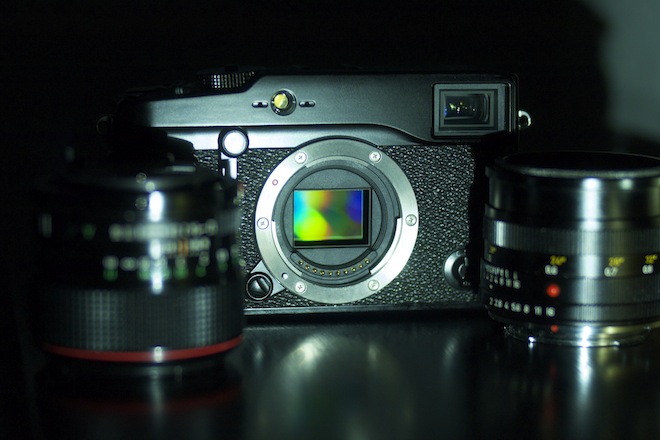
There is more to this camera than meets the eye. In my first look I was rather taken aback by the eccentricities of the camera and just could not work out what it offered over the cheaper NEX 7. Now in a surprised double-take, I am beginning to believe it is actually the best mirrorless on the market for stills. And the 1080p video mode – once you know the limitations – is capable of producing incredible results.
To a certain extent Fuji may be milking the interest they created with the X100 in the expansion of the X range and the price of the X Pro 1, but there’s a very solid non-speculative hardware related reason for the high price as well.
4 of them in fact:
- Bespoke sensor design unlike any other CMOS
- RGBW LCD panel
- Hybrid viewfinder and EVF
- It is the highest performing mirrorless camera in the world for stills and high ISO
EVF
I feel I was too harsh on the EVF in my first look. It isn’t actually that far off the Sony NEX 7’s OLED TruFinder and it is better than the one in the GH2. Compared to the GH2’s it does not throw rainbows around as you pan and it has a higher contrast with more lifelike colour. It is just that the NEX 7’s OLED panel set a very high benchmark.
However it soon becomes apparent that there are subtle but important differences where the Fuji X Pro 1 does better than the NEX 7’s OLED.
If you don’t have your eye perfectly square to the viewfinder on the NEX 7, bright parts of the image ghost a little and corner sharpness falls off very readily. The optical design of the Fuji X Pro 1’s viewfinder is superior – probably because it has more room to work with, being a bigger unit than the assembly on the NEX 7.
Yes manually focussing takes too many turns and the AF is rubbish – but the point of the X Pro 1 is that you get an interchangeable lens mount to put all your lovely manual focus glass on. Canon FD, Nikon F, Leica M, the lot… The AF and fly-by-wire MF are limitations of the Fuji lens not the camera, manually focussing a Leica or Voigtlander mechanically via the EVF on the Fuji X Pro 1 will feel far better than doing so on the handling flawed Fuji X Pro 1 lenses.
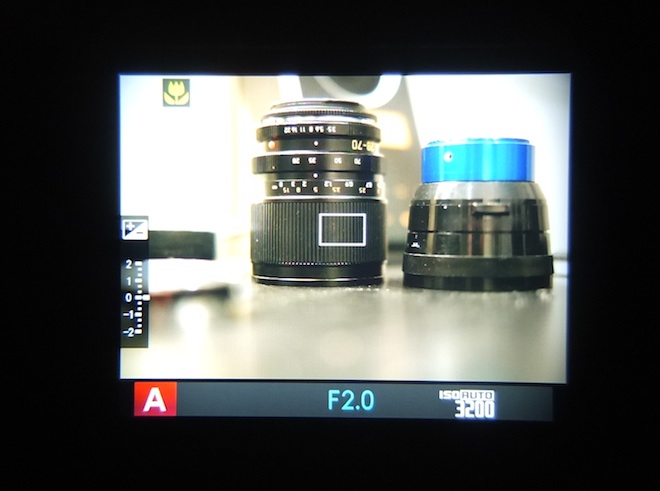
Above: a look inside the Fuji X Pro 1’s improved hybrid viewfinder, with EVF activated
Sensor
The sensor in the much cheaper Fuji X100 is still very good but a standard CMOS, the one in the X Pro 1 is more like Foveon and a completely bespoke Fuji design. Sensor development is not cheap. Canon and Sony DSLR CMOS technology uses a standard bayer arrangement apart from in the Canon C300 where it is again a very expensive custom bayer variation.
No surprise what the Fuji X Pro 1 sensor has – a very expensive custom bayer variation. This helps to explain some of the high price relative to the Sony NEX 7.
It accounts for the R&D effort Fuji put in to create the new sensor and the way to prove it is to look at RAW stills at 100% – they look far cleaner at the per pixel level than those from the higher resolution NEX 7. Although the sensor is 16MP in the Fuji, the custom bayer pattern and lack of anti-aliasing filter means it performs more like a 24MP standard CMOS in terms of real resolution, but with none of the drawbacks of noisy high ISOs.
This is big news – being able to shoot with the most advanced APS-C sensor on the market with an interchangeable mirrorless lens mount should not be taken for granted, it really does your glass justice. The NEX 7’s sensor was until now the cutting edge. This beats it. And you cannot use as wide a range of glass on a full frame DSLR like the 5D Mark III or D800 because they don’t have mirrorless mounts.
Whereas the NEX 7’s image has a yellowish and muddy tinge to it at high ISOs, the Fuji X Pro 1 holds onto accurate, deep rich velvety colour tones.
The Fuji X Pro 1 stomps all over the NEX 7 at ISO 1600, 3200, 6400 and 12,800 for low noise performance and it has a fine film-like grain in RAW stills mode.
The video mode (though limited) is good for Bolex style snapshots of life and shallow DOF medium close-ups
The last generation of Canon DSLRs with aliasing and moire worked best with shallow depth of field medium close ups of actors. They did not excel at fine high contrast detail, wide angle architecture and landscape. Far better at 85mm F1.4 and pointed at a human being. This is exactly how you should use the Fuji X Pro 1 in video mode because although it has a fantastic sensor and 24p, it lacks an anti-aliasing filter at all and does not scale the sensor with as much finesse as the GH2.
As a result it has heavier aliasing and more than even the Canon 5D Mark II but apart from that one aspect it is capable of amazing stuff. If you use a softening filter on the lens, or focus on a subject without harsh high contrast edges 1080p from the Fuji is detailed with very little noise at high ISOs. It isn’t an all-purpose video camera by any means and it lacks full manual control which is a great shame – but you can focus manually, turn of AF and set the aperture manually (only before recording if you’re using the Fuji lens with fly-by-wire aperture and focus ring). Shutter and ISO are chosen for you quite intelligently. As a b-cam it will work out if you understand the limitations.
The actual amount of detail captured in 1080p, although not that clean, is actually rather high – and don’t forget that sensor.
A shot that the X Pro 1 excels at in video mode:
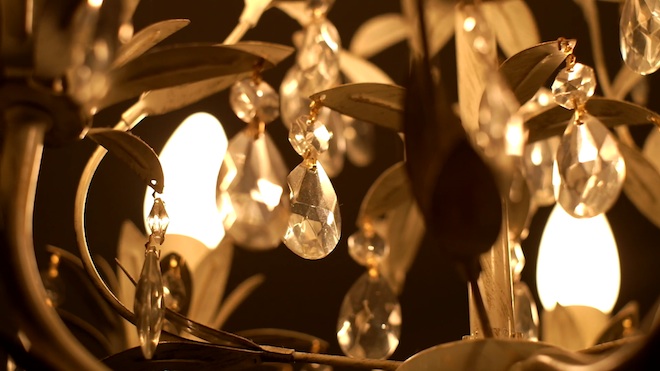
A shot where it falls down badly relative to the GH2 or 5D Mark III – hard to show in a still frame capture – but there are lots of jumpy animated outlines when in motion, where solid smooth high contrast outlines should be on the lenses – notice the false colour on the table edge as well.
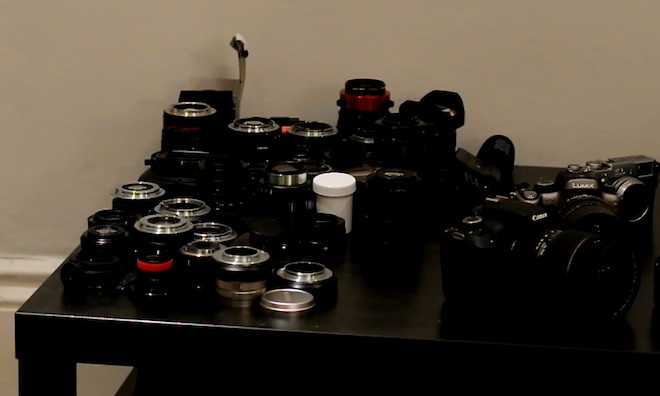
The feel
Again something that only hits you after some days of intensive shooting is how zen-like the Fuji X Pro 1 feels. Once you wrap your head around it, operationally it becomes 2nd nature. The quick menu is probably the best implemented on any camera – a lot better than the NEX 7’s convoluted manner in which settings such as white balance can be assigned to a programmable button and then requires 3 dials, a d-pad and a confirm button to adjust! Too much! Although I like dials a lot, the Fuji is more straight forward and less like a Playstation. I like to put it in aperture priority, auto ISO and use the exposure compensation dial instead of manually setting shutter and ISO, and the aperture purely to vary depth of field. That way you have almost total control but can get on with shooting and not dialling.
The camera is light but tactile, good looking and just feels nicer to hold than the NEX 7. Most importantly the camera makes me want to go out and shoot with it, which in many ways is even more important than outright performance. It does have an ‘x-factor’ and it is an inspiring tool to use.
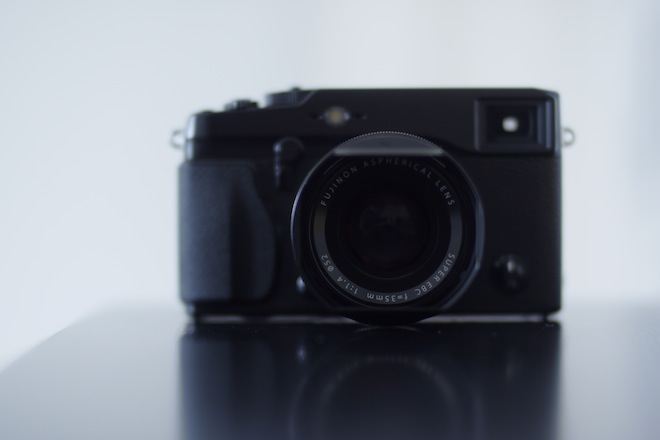
Maybe Sony and Fuji have more in common than we think
There’s speculation that the Fuji X Pro 1 has one of Sony’s new WhiteMagic LCD panels for the main screen, which is one of the first of it’s kind in any prosumer device. Rather than a grid of red, blue and green pixels the LCD also has a pure white element for better brightness, better energy usage, contrast and colour accuracy.
This main LCD is one-up on the NEX 7’s main flip out LCD and is more at the OLED standard. Dialing up the brightness on this screen does not result in it washing out like a typical LCD or LED backlit screen, it just gets more bright, and more vivid.
Responsiveness
Focus on the new Fuji X lenses aside, the X Pro 1 as a camera body is very responsive with fast continuous shooting of 6fps and a generally responsive feel to menus. Faster processors are used than in the older X100 and it shows.
Fuji X Mount Lenses
I cannot recommend the expensive X mount lenses. Great optics but terrible focussing. If this was limited to slow-ish AF (which I actually find pretty accurate, just noisy and slow) it wouldn’t be so bad. But it takes so many turns of the ring that by the time you get from infinity to close up your wrist has suffered repetitive strain injury. Of course Leica users suffer from this before even using a camera! (Disclaimer: that was a joke).
I hope Fuji have the patents and expertise to emulate what Olympus and Panasonic have done, and implement the next generation of AF and fly-by-wire manual focussing on future X lenses. One look at the Olympus 45mm F1.8 will tell you that Fuji are behind on the X mount glass focussing technology big time, if not the optical side.
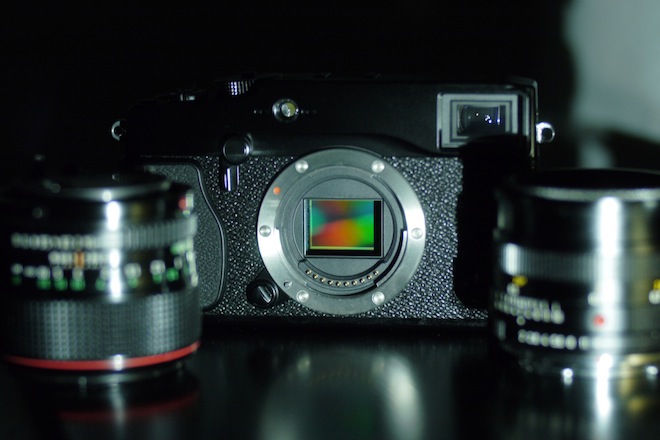
(Above: the lenses I will look forward to using on the X Pro 1 once the adapters are out – the Leica R 50mm F2 and Canon FD 50mm F1.2L – the range of lenses you can use is only limited by the APS-C sensor size since it is a mirrorless mount with very short flange back – shorter even than Micro Four Thirds)
Should you get one for video?
For video alone definitely not – because the 5D Mark III and GH2 are formidable digital cinema cameras and the X Pro 1 doesn’t have the same focus on video, the same image quality or the same in features. Video optimised image processing, encoding and sensor output counts for a lot in video mode – even though the X Pro 1 has a far superior sensor than the GH2 has, it is nowhere near in terms of clean resolution without artefacts.
Should you get one for stills?
Even though the NEX 7 is cheaper I’d say that if you can justify the expense the X Pro 1 might be hands down the better camera! And let me be clear, this has surprised me more than a live handgun in a cuckoo clock.
The NEX 7 was seriously good and yet the mirrorless bar has somehow been moved higher, memories of el-cheapo consumer GF3s and PENs almost obliterated. I’ve always said on EOSHD that the right direction for mirrorless cameras is up-market – and toward the future – rather than as compact step-up cameras or dumbed down DSLR alternatives – and now the popularity of the new high end mirrorless stuff seems to back that up!!
Just make sure you allocate the money you were going to spend on a Fuji 35mm F1.4 X to those nice chaps in Hong Kong who make lens adapters. Already there is a Nikon F mount, Contax G and Leica M adapter available.


